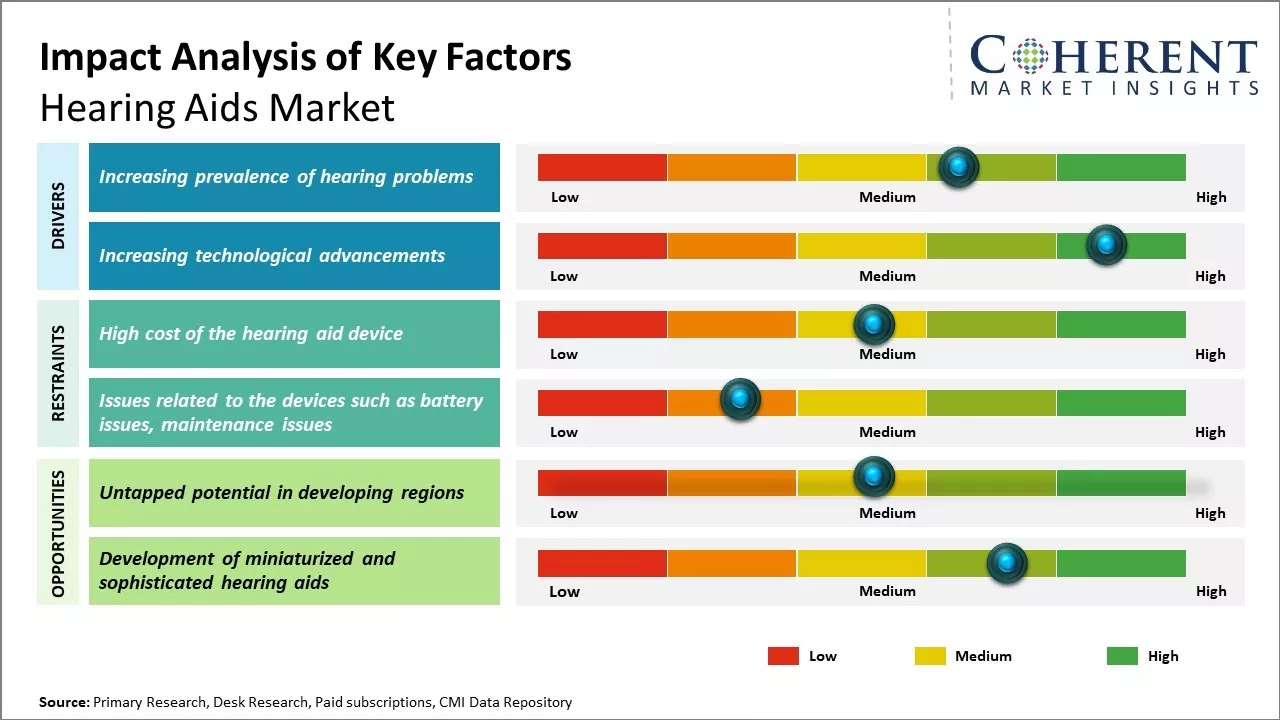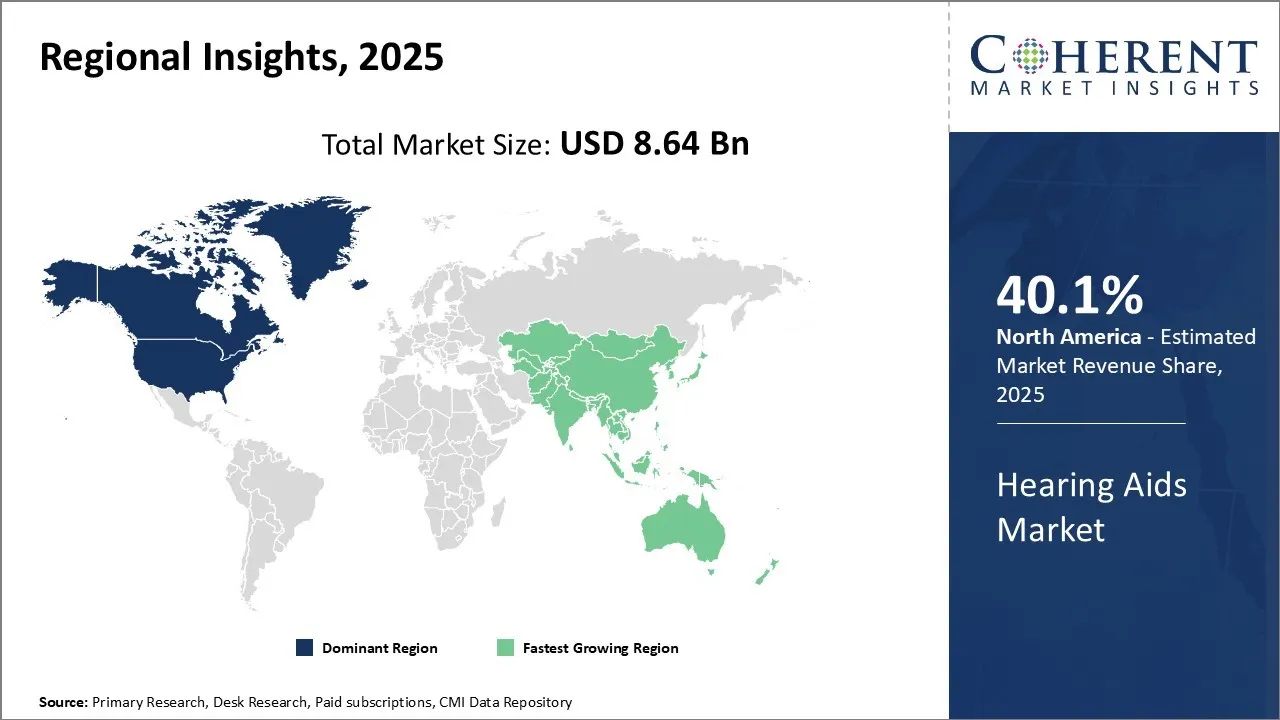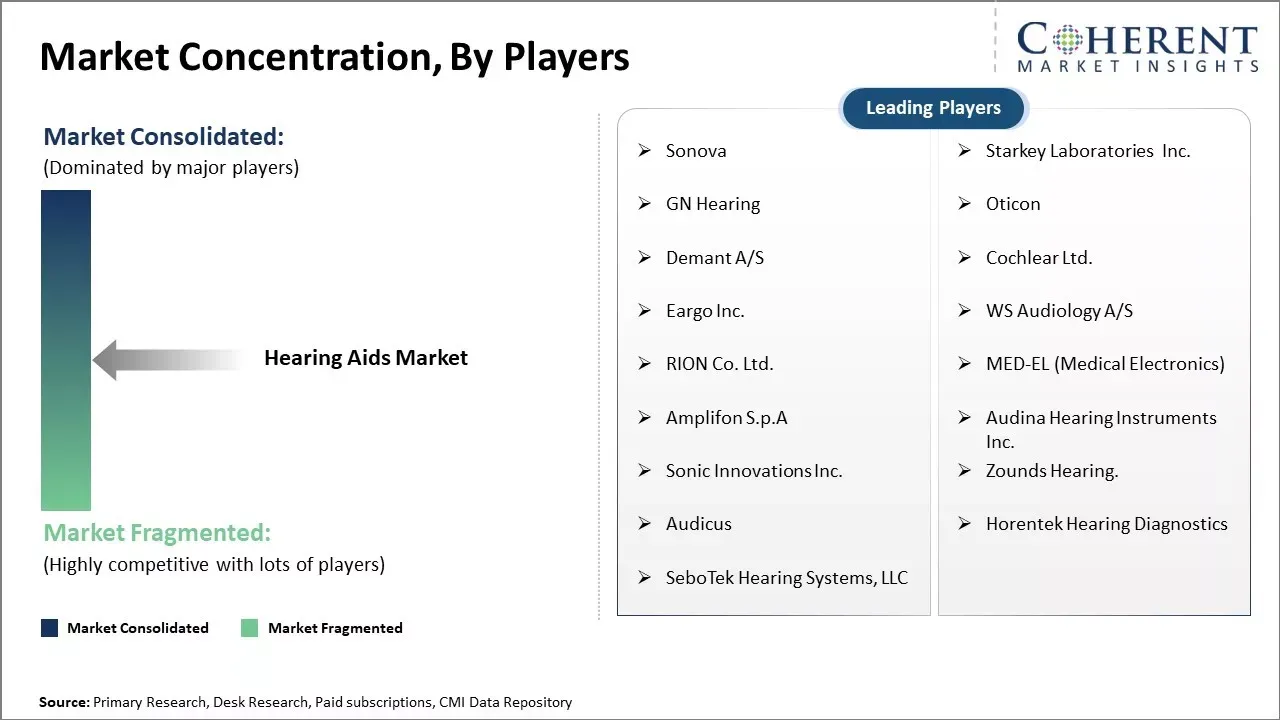Global hearing aids market is estimated to be valued at USD 8.64 Bn in 2025 and is expected to reach USD 13.52 Bn by 2032, exhibiting a compound annual growth rate (CAGR) of 6.6% from 2025 to 2032.

To learn more about this report, Download Free Sample
Global hearing aids market is expected to witness positive growth over the forecast period. There is an increasing prevalence of hearing loss majorly among the geriatric population globally. Growing noise pollution levels and increased adoption of unsafe listening habits among consumers is also contributing to the rising cases of hearing impairment. Further, innovation led by key players in terms of the development of miniature and sophisticated hearing aid technologies is supporting the market expansion. However, issues related to the social stigma associated with hearing loss and high cost of hearing aids are likely to hinder the market growth to some extent during the forecast period.
|
Current Event |
Description and its Impact |
|
Aging Demographics and Healthcare Policy Changes |
|
|
Over-the-Counter (OTC) Hearing Aids Regulatory Shift |
|
Uncover macros and micros vetted on 75+ parameters: Get instant access to report
In terms of product type, the hearing aid devices segment is anticipated to hold 78.9% of the market share in 2025. Hearing aid devices have transformed significantly over the past few decades, becoming more comfortable, affordable and discreet. Advanced digital technology allows devices to filter ambient noise and focus on wanted speech sounds. Software-based programs fine-tune hearing aids for individual needs and listening environments. Rechargeable batteries have made devices more convenient while miniaturization makes them less visible.
For instance, in August 2025, GN released the world's smallest rechargeable hearing aid, which is both high-tech and small. The new feature makes it easier to use, more portable, and more comfortable for adults with hearing loss. This breakthrough makes GN's device portfolio stronger by adding hearing solutions that are discreet, reliable, and easy to find in the growing global market.
In terms of type of hearing loss, the sensorineural hearing loss segment contributes the highest share of the hearing aids market and is projected to hold 47.3% of the market share in 2025. Approximately 50-60% of cases are attributed to hereditary damage or degeneration of inner ear sensory cells and auditory nerves over time. Family history is a strong risk factor as many types demonstrate Mendelian or complex inheritance patterns. Additionally, certain genetic mutations and syndromes are linked to childhood-onset cases.
For instance, in November 2025, Oticon launched with a discreet in-the-ear hearing aid for adults with sensorineural hearing loss. The device has a comfortable, almost invisible design and uses advanced digital processing to make speech clearer and everyday listening better. This launch adds to Oticon's portfolio by giving people with the most common type of hearing loss personalized solutions.
In terms of patient type, the adults segment contributes the highest share of the hearing aids market and is projected to hold 78.7% of the market share in 2025. Presbycusis or age-related hearing loss affects about 40-50% of 65–75-year-olds and up to 80% of those above 75 years. It is typically bilateral, progressive and permanent. Pathology involves degeneration of cochlear hair cells and neural connections over time. Lifestyle noise exposure from occupations like farming, construction also adds to adult non-congenital cases. Impaired communication poses challenges for independent living and workplace safety.
For instance, Apple is turning AirPods into hearing aids for adults with mild to moderate hearing loss. This new idea makes things more accessible by adding health-related features to a popular consumer device. Apple wants to bridge the gap between convenience and medical functionality in the growing health-tech market by changing hearing aids for adults.
In terms of sales channel, the otolaryngology clinics segment is expected to lead with the largest share of the market in 2025, as patients trust expert diagnosis, precise fitting, and ongoing aftercare. Clinics provide personalized solutions that ensure device effectiveness and satisfaction. While e-commerce grows rapidly with OTC hearing aids and retail stores offer accessibility, clinical channels remain the most reliable and preferred option.
For instance, in June 2024, HearClear opened a new clinic in Mumbai's Hiranandani Estate that offers advanced hearing care. The facility does diagnostic tests like PTA, OAE, BERA, and VNG, as well as fitting, reprogramming, and speech therapy for hearing aids. It improves access to personalized hearing solutions for patients by being led by expert audiologists.

To learn more about this report, Download Free Sample
The North America region currently dominates the global hearing aids market and is projected to hold 40.1% of the market share in 2025. With the U.S. accounting for the majority of sales, factors such as the high penetration of digital hearing aid devices, presence of leading global manufacturers, and growing geriatric population have contributed to its large market share. Moreover, favorable insurance coverage and reimbursement policies have facilitated market expansion.
For instance, in August 2025, Sonova introduced Phonak's smallest and first rechargeable in-the-ear hearing aid to its Infinio line. The device was announced in Switzerland and then released in the U.S. It combines miniaturization with cutting-edge rechargeable technology. This new idea makes things more comfortable, private, and easy to get to.
The Asia Pacific region, on the other hand, is emerging as the fastest growing market for hearing aids. Rapid economic development and rising disposable incomes have increased spend on healthcare across nations like China, India and South Korea. This has driven focus onto quality-of-life aspects including hearing loss. Growing medical tourism in these countries is also encouraging device imports. Key players like Sonova and Demant are establishing local manufacturing units in Asia to address the untapped regional demand. This allows addressing specific price sensitivities and complies with developing "Make in India" policies.
For instance, in December 2025, The International Innovation Awards 2025 in Shanghai presented an award to OK Biotech, which is based in Taiwan, for its OTC hearing aid innovation. The award shows how far we've come in making hearing aids more affordable and easier to get, giving consumers more choices outside of clinical settings and making Asia-Pacific a leader in hearing care technology innovation.
The U.S. hearing aids market in 2025 is expected to be driven by an aging population, more people losing their hearing, and FDA-approved over-the-counter devices. Improvements in AI, rechargeable technology, and designs that are hard to see make people more likely to use them. More awareness, lower prices, and easier access for consumers are driving strong demand for adult hearing care.
For instance, in October 2025, Starkey, which is based in Minnesota, added AI and deep neural networks to its hearing aids. The new technology makes speech clearer, works in different listening environments, and customizes sound for each user. This breakthrough puts Starkey at the top of the field of advanced hearing technology, changing the way adults with hearing loss around the world get help.
In March 2025, Phonak, a Swiss brand owned by Sonova, is growing in China to help with the rise in hearing loss. The company made advanced hearing aids that were made to fit the needs of the area, making them easier to get and raising awareness. This move makes Phonak's presence in Asia stronger by providing discreet, effective solutions and meeting China's growing need for modern hearing care technology.
| Report Coverage | Details | ||
|---|---|---|---|
| Base Year: | 2024 | Market Size in 2025: | USD 8.64 Bn |
| Historical Data for: | 2020 To 2024 | Forecast Period: | 2025 To 2032 |
| Forecast Period 2025 to 2032 CAGR: | 6.6% | 2032 Value Projection: | USD 13.52 Bn |
| Geographies covered: |
|
||
| Segments covered: |
|
||
| Companies covered: |
Sonova, Starkey Laboratories Inc., GN Hearing, Oticon, Demant A/S, Cochlear Ltd., Eargo Inc., WS Audiology A/S, RION Co. Ltd., MED-EL (Medical Electronics), Amplifon S.p.A, Audina Hearing Instruments Inc., Sonic Innovations Inc., Zounds Hearing., Audicus, Horentek Hearing Diagnostics, SeboTek Hearing Systems, LLC |
||
| Growth Drivers: |
|
||
| Restraints & Challenges: |
|
||
Uncover macros and micros vetted on 75+ parameters: Get instant access to report
The rising prevalence of hearing problems, including ear infections and age-related hearing loss, is driving demand for advanced solutions. This trend is expected to significantly boost global growth and expand the hearing aids market share, as consumers increasingly adopt innovative, discreet, and rechargeable devices to improve accessibility and quality of life.
Technological advancements such as AI integration, rechargeable batteries, Bluetooth connectivity, and discreet designs are transforming hearing aid devices. These innovations enhance user experience, improve speech clarity, and increase accessibility. As a result, hearing aids market demand is rising globally, driven by consumer preference for modern, efficient, and personalized hearing solutions.
The potential for growth in the global hearing aids market is substantial, particularly in developing regions across the world. Regions such as Southeast Asia, Latin America, and parts of Africa presently exhibit hearing aid penetration rates significantly lower than those observed in developed nations. This untapped pool of potential users represents a major opportunity for hearing aid manufacturers. As economies in developing areas continue to grow and populations become more health-conscious, demand for hearing aids is likely to rise substantially.

To learn more about this report, Download Free Sample
Definition: The hearing aids market consists of devices that amplify sound for the wearer. They are used by people suffering from hearing loss of different ranges from mild to severe. Hearing aids come in various styles including behind-the-ear, in-the-ear, and completely-in-the-canal devices. They utilize microphones to capture sound, an amplifier to increase the volume of sound, and a speaker to transmit the amplified sound.
Share
Share
About Author
Manisha Vibhute is a consultant with over 5 years of experience in market research and consulting. With a strong understanding of market dynamics, Manisha assists clients in developing effective market access strategies. She helps medical device companies navigate pricing, reimbursement, and regulatory pathways to ensure successful product launches.
Missing comfort of reading report in your local language? Find your preferred language :
Transform your Strategy with Exclusive Trending Reports :
Frequently Asked Questions
Joining thousands of companies around the world committed to making the Excellent Business Solutions.
View All Our Clients